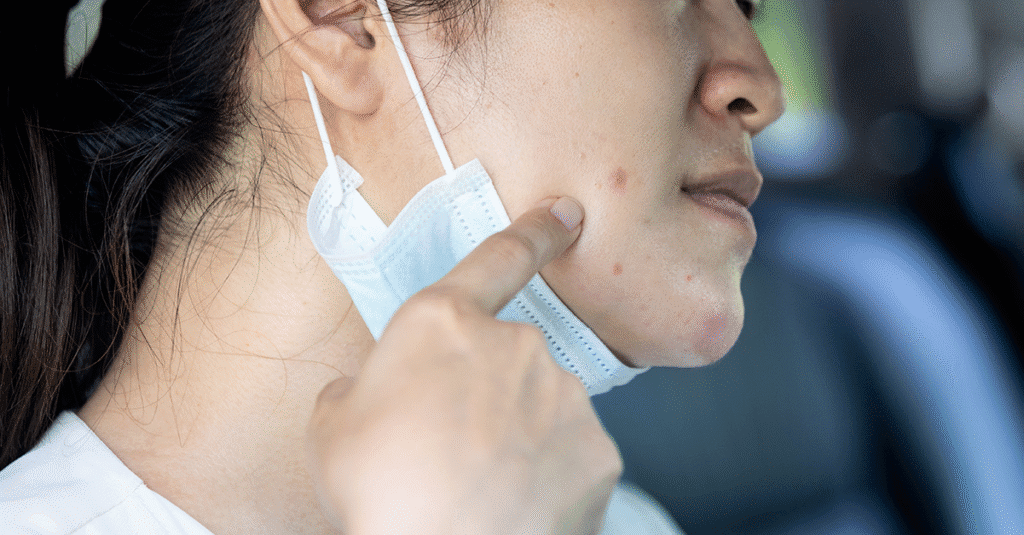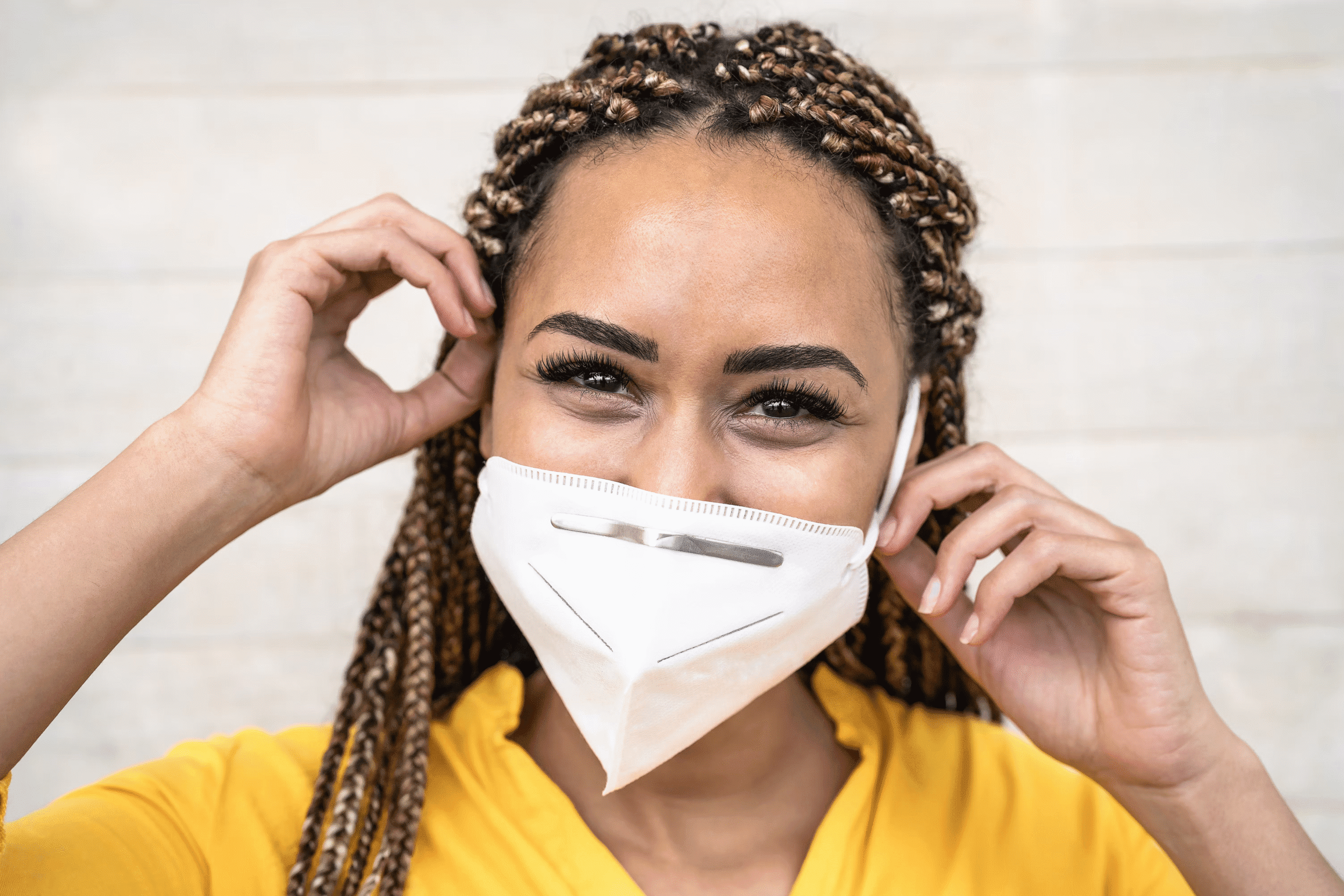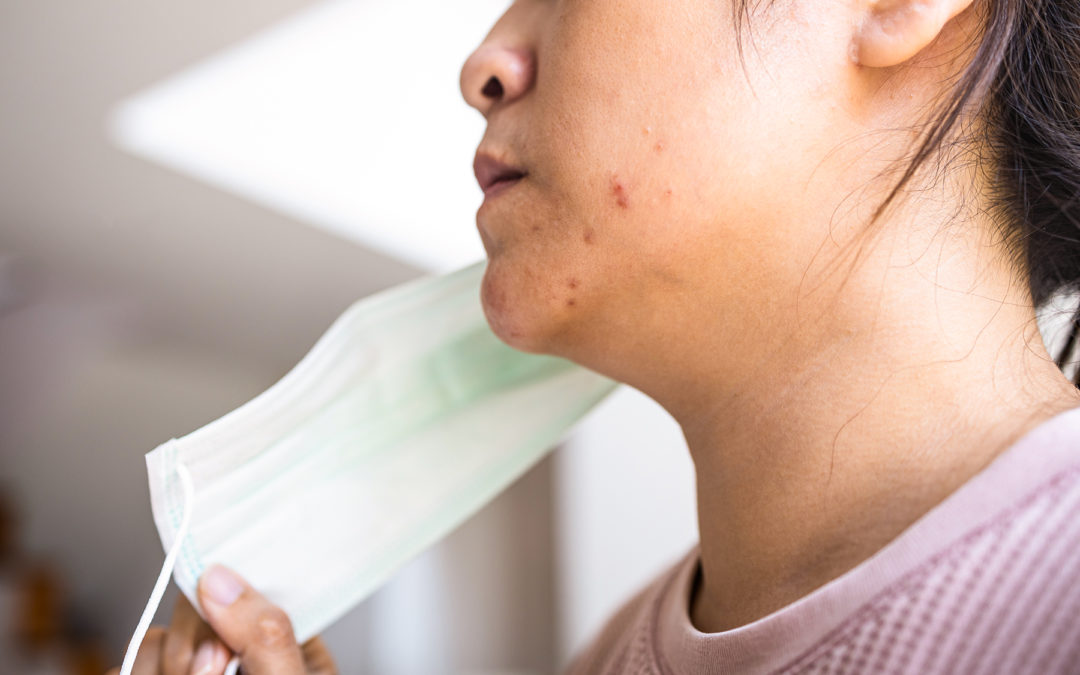To slow the spread of COVID-19, face masks became a daily necessity. However, frequent mask-wearing can cause skin issues commonly known as maskne (mask acne).
Maskne doesn’t just cause pimples. It can also lead to redness, irritation, bumpiness, and trigger conditions like dermatitis or folliculitis.
If you’re dealing with skin flare-ups due to mask use, here’s what you need to know.
What to Know About Maskne Skin Conditions
“Maskne” is a general term for various skin issues caused by prolonged mask-wearing:
- Acne: Pores get clogged by oil, dead skin, and bacteria, leading to pimples, blackheads, or whiteheads. More common with surgical masks and respirators.
- Rosacea: Masks can worsen this condition, causing redness and pimples.
- Irritant contact dermatitis: Results from sensitivity to mask materials. Appears as a red rash with irritation or blisters.
- Atopic eczema: Mask-wearing can trigger or worsen eczema symptoms.
- Periorificial dermatitis: Small pimples form around the mouth and eyes, often worsened by cosmetics or steroid creams.
- Folliculitis: Infected hair follicles cause acne-like bumps, with itching or pain.
- Urticaria (hives): Raised welts may form due to pressure or allergic reactions to mask components (like latex).
- Seborrheic dermatitis: Yellow, greasy scales on the scalp, eyebrows, and facial folds.
Existing skin conditions can make you more prone to maskne, but even people with healthy skin may develop symptoms from long-term mask use, especially with tight, synthetic, or medical-grade masks.
What Causes Maskne?

There are several possible causes:
- Clogged pores: Trapped oil, dirt, and bacteria are worsened by humidity under the mask.
- Friction: Constant rubbing from the mask can irritate the skin.
- Material sensitivity: Certain mask fabrics or laundry detergents can trigger allergic reactions.
How to Treat Maskne
Even if you have maskne, continue wearing your mask. You can treat symptoms by following a consistent skincare routine.
1. Wash Your Face Regularly
- Once in the morning
- Once before bed
- After sweating or wearing a mask
Use lukewarm water and a gentle touch. Avoid harsh scrubbing.
2. Use a Gentle Cleanser
Avoid alcohol- or fragrance-based cleansers. If breakouts persist, try acne-fighting ingredients like benzoyl peroxide or salicylic acid.
3. Apply Noncomedogenic Moisturizer
Moisturizers with “noncomedogenic” labels won’t clog pores and help maintain a healthy skin barrier.
4. Use Cortisone Cream for Irritation
Mild hydrocortisone cream, paired with a ceramide-based moisturizer, can relieve inflammation.
5. Skip the Makeup
Foundation, concealer, and blush can clog pores and slow down recovery.
Maskne Prevention Tips

1. Wash Fabric Masks After Every Use
- Use unscented, hypoallergenic detergent
- Let masks dry completely
- Store used masks in a sealed plastic bag until washed
2. Apply Topical Antimicrobial Cream
Helps reduce bacteria buildup. Ask a pharmacist or dermatologist for OTC options.
3. Toss Disposable Masks After Each Use
Single-use masks shouldn’t be reused. Always dispose of them responsibly to reduce pollution.
4. Remove Mask Every 4 Hours
According to the American Academy of Dermatology, removing the mask for 15 minutes every 4 hours gives your skin a break (only when physically distant from others).
5. Apply Moisturizer Before Wearing a Mask
A lightweight moisturizer can reduce dryness and act as a buffer between your skin and the mask.
6. Choose the Right Mask
Opt for masks that:
- Fit snugly but comfortably
- Have at least 2 layers of soft, breathable fabric (like cotton)
- Contain a nose wire for a better fit
Avoid synthetic materials like nylon or rayon.
7. Wash Your Face After Wearing a Mask
Cleanse and moisturize your face when you get home, especially if you’ve been sweating.
Treating Specific Conditions
- Contact dermatitis: Use 1% hydrocortisone ointment
- Infection: May require antibiotics (topical or oral)
- Seborrheic dermatitis: Antifungal shampoo (ketoconazole 2%) + topical corticosteroids
- Rosacea: Topical ivermectin (1%) or oral antibiotics
- Folliculitis: Gentle cleansing, exfoliation, antimicrobial cream, or antibiotics if needed
If using surgical masks or respirators:
- Ensure a proper but not overly tight fit
- Use emollients 30 minutes before wearing PPE
- Consider silicon-backed dressings for protection
- Stay hydrated throughout the day
Also Read : The Ultimate Guide to a Natural Anti-Aging Skincare Routine That Works Wonders



